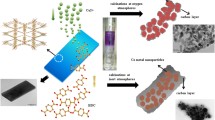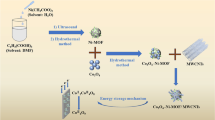Abstract
Searching for new metal–organic frameworks with excellent electrochemical performances is considerably important to advance their application in supercapacitors. Herein, a Co5-cluster-based three-dimensional (3D) metal–organic framework (Co5(OH)2(O2CCH3)8·2H2O, Co5-MOF) was synthesized and characterized by X-ray powder diffraction, infrared spectroscopy, thermogravimetric analysis, X-ray photoelectron spectroscopy, scanning electron microscopy, and nitrogen adsorption–desorption. The Co5-MOF as an electrode material of supercapacitors was investigated for the first time. In a three-electrode system, the highest specific capacitance for the Co5-MOF electrode is 867 F g−1 at 1 A g−1, and the specific capacitance still remains 90.3% of the original specific capacitance after 3000 cycles, displaying its good long-term cycle stability. The asymmetric supercapacitor based on the Co5-MOF as the positive electrode and the rGO as the negative electrode presented a high energy density of 18 W h kg−1 at a power density of 0.7 kW kg−1. The high supercapacitive properties may be attributed to the nano-sized Co5-MOF particles with larger specific surface area and pore structure.

Co5-cluster-based MOF was synthesized by the solvothermal reaction, which displays excellent cyclic stability, better rate capability, and higher specific capacity as an electrode material for supercapacitors.







Similar content being viewed by others
References
Whittingham MS (2014) Ultimate limits to intercalation reactions for lithium batteries. Chem Rev 114(23):11414–11443
Goodenough JB (2014) Electrochemical energy storage in a sustainable modern society. Energy Environ Sci 7(1):14–18
Liang Z, Qu C, Guo W, Zou R, Xu Q (2018) Pristine metal-organic frameworks and their composites for energy storage and conversion. Adv Mater 30(37):1702891
Zhao J, Jiang YF, Fan H, Liu M, Zhuo O, Wang XZ, Wu Q, Yang LJ, Ma YW, Hu Z (2017) Porous 3D few-layer graphene-like carbon for ultrahigh-power supercapacitors with well-defined structure–performance relationship. Adv Mater:1604569
Wei QL, Xiong FY, Tan SS, Huang L, Lan Esther H, Dunn B, Mai LQ (2017) Porous one-dimensional nanomaterials: design, fabrication and applications in electrochemical energy storage. Adv Mater 1602300
Zhang P, Guan BY, Yu L, Lou XW (2017) Formation of double-shelled zinc-cobalt sulfide dodecahedral cages from bimetallic zeolitic imidazolate frameworks for hybrid supercapacitors. Angew Chem Int Ed 56(25):7141–7145
Simon P, Gogotsi Y (2009) Materials for electrochemical capacitors. Nat Mater:320–329
Fan LZ, Hu YS, Maier J, Adelhelm P, Smarsly B, Antonietti M (2007) High electroactivity of polyaniline in supercapacitors by using a hierarchically porous carbon monolith as a support. Adv Funct Mater 17(16):3083–3087
Zhang LL, Zhao XS (2009) Carbon-based materials as supercapacitor electrodes. Chem Soc Rev 38(9):2520–2531
Yi M, Zhang C, Cao C, Xu C, Sa B, Cai D, Zhan H (2019) MOF-derived hybrid hollow submicrospheres of nitrogen-doped carbon-encapsulated bimetallic Ni-Co-S nanoparticles for supercapacitors and lithium ion batteries. Inorg Chem 58(6):3916–3924
Zhang C, Yin H, Han M, Dai Z, Pang H, Zheng Y (2014) Two-dimensional tin selenide nanostructures for flexible all-solid-state supercapacitors. ACS nano 8(4):3761–3770
Liu C, Zhao S, Lu Y, Chang Y, Xu D, Wang Q (2017) 3D porous nanoarchitectures derived from SnS/S-doped graphene hybrid nanosheets for flexible all-solid-state supercapacitors. Small 13(12)
Gong J, Li JC, Yang J, Zhao S, Yang Z, Zhang K (2018) High-performance flexible in-plane micro-supercapacitors based on vertically aligned CuSe@Ni(OH)2 hybrid nanosheet films. ACS applied materials & interfaces 10(44):38341–38349
Xi C, Zhu G, Liu Y, Shen X, Zhu W, Ji Z (2018) Belt-like nickel hydroxide carbonate/reduced graphene oxide hybrids: synthesis and performance as supercapacitor electrodes. Colloids and Surfaces A: Physicochemical and Engineering Aspects 538:748–756
Saraf M, Natarajan K, Mobin SM (2018) Emerging robust heterostructure of MoS2-rGO for high-performance supercapacitors. ACS Appl Mater Interfaces 10(19):16588–16595
Choi BG, Yang M, Hong WH, Choi JW, Huh YS (2012) 3D macroporous graphene frameworks for supercapacitors with high energy and power densities. ACS Nano 6(5):4020–4028
Wen P, Gong P, Sun J, Wang J, Yang S (2015) Design and synthesis of Ni-MOF/CNT composites and rGO/carbon nitride composites for an asymmetric supercapacitor with high energy and power density. J Mater Chem A 3(26):13874–13883
Forse AC, Merlet C, Griffin JM, Grey CP (2016) New perspectives on the charging mechanisms of supercapacitors. J Am Chem Soc 138(18):5731–5744
Furukawa H, Cordova KE, O'Keeffe M, Yaghi OM (2013) The chemistry and applications of metal-organic frameworks. Science 341(6149):1230444
Stock N, Biswas S (2012) Synthesis of metal-organic frameworks (MOFs): routes to various MOF topologies, morphologies, and composites. Chem Rev 112(2):933–969
Su J, Hu TH, Murase R, Wang HY, D’Alessandro DM, Kurmoo M, Zuo JL (2019) Redox activities of metal−organic frameworks incorporating rare-earth metal chains and tetrathiafulvalene linkers. Inorg Chem 58:3698–3706
Liu Q, Yu L, Wang Y, Ji Y, Horvat J, Cheng ML, Jia X, Wang G (2013) Manganese-based layered coordination polymer: synthesis, structural characterization, magnetic property, and electrochemical performance in lithium-ion batteries. Inorg Chem 52:2817–2822
Song YD, Yu LL, Gao YR, Shi CD, Cheng ML, Wang XM, Liu HJ, Liu Q (2017) One-dimensional zinc-based coordination polymer as a higher capacity anode material for lithium ion batteries. Inorg Chem 56(17):11603–11609
Sun GC, Yu LL, Hu Y, Sha YY, Rong HR, Li BL, Liu HJ, Liu Q (2019) A manganese-based coordination polymer containing no solvent as a high performance anode in Li-ion batteries. Cryst Growth Des 19:6503–6510
Wang L, Feng X, Ren L, Piao Q, Zhong J, Wang Y, Li H, Chen Y, Wang B (2015) Flexible solid-state supercapacitor based on a metal-organic framework interwoven by electrochemically-deposited PANI. J Am Chem Soc 137(15):4920–4923
Choi KM, Jeong HM, Park JH, Zhang YB, Kang JK, Yaghi OM (2014) Supercapacitors of nanocrystalline metal-organic frameworks. ACS Nano 8(7):7451–7457
Yang J, Ma Z, Gao W, Wei M (2017) Layered structural Co-based MOF with conductive network frames as a new supercapacitor electrode. Chem Eur J 23(3):631–636
Kazemi SH, Hosseinzadeh B, Kazemi H, Kiani MA, Hajati S (2018) Facile synthesis of mixed metal-organic frameworks: electrode materials for supercapacitors with excellent areal capacitance and operational stability. ACS Appl Mater Interfaces 10(27):23063–23073
Morozan A, Jaouen F (2012) Metal organic frameworks for electrochemical applications. Energy Environ Sci 5(11):9269
Zheng SS, Xue HG, Pang H (2018) Supercapacitors based on metal coordination materials. Coordin Chem Rev 373:2–21
Wang L, Han Y, Feng X, Zhou J, Qi P, Wang B (2016) Metal–organic frameworks for energy storage: batteries and supercapacitors. Coordin Chem Rev 307:361–381
Li SL, Xu Q (2013) Metal–organic frameworks as platforms for clean energy. Energy Environ Sci 6(6):1656
Lee DY, Yoon SJ, Shrestha NK, Lee SH, Ahn H, Han SH (2012) Unusual energy storage and charge retention in Co-based metal–organic-frameworks. Micropor Mesopor Mat 153:163–165
Yang J, Zheng C, Xiong P, Li Y, Wei M (2014) Zn-doped Ni-MOF material with a high supercapacitive performance. J Mater Chem A 2(44):19005–19010
Kang L, Sun SX, Kong LB, Lang JW, Luo YC (2014) Investigating metal-organic framework as a new pseudo-capacitive material for supercapacitors. Chinese Chem Lett 25(6):957–961
Yan Y, Gu P, Zheng S, Zheng M, Pang H, Xue H (2016) Facile synthesis of an accordion-like Ni-MOF superstructure for high-performance flexible supercapacitors. J Mater Chem A 4(48):19078–19085
Du M, Chen M, Yang XG, Wen J, Wang X, Fang SM, Liu CS (2014) A channel-type mesoporous In(III)–carboxylate coordination framework with high physicochemical stability for use as an electrode material in supercapacitors. J Mater Chem A 2(25):9828–9834
Díaz R, Orcajo MG, Botas JA, Calleja G, Palma J (2012) Co8-MOF-5 as electrode for supercapacitors. Mater Lett 68:126–128
Liu X, Shi C, Zhai C, Cheng M, Liu Q, Wang G (2016) Cobalt-based layered metal-organic framework as an ultrahigh capacity supercapacitor electrode material. ACS Appl Mater Interfaces 8(7):4585–4591
Yang J, Xiong P, Zheng C, Qiu H, Wei M (2014) Metal–organic frameworks: a new promising class of materials for a high performance supercapacitor electrode. J Mater Chem A 2(39):16640–16644
Sheberla D, Bachman JC, Elias JS, Sun CJ, Y SH (2017) Conductive MOF electrodes for stable supercapacitors with high areal capacitance. Nat Mater 16(2):220–224
Yu L, Wang X, Cheng M, Rong H, Song Y, Liu Q (2017) A three-dimensional copper coordination polymer constructed by 3-methyl-1H-pyrazole-4-carboxylic acid with higher capacitance for supercapacitors. Cryst Growth Des 18(1):280–285
Song H, Shen L, Wang C (2014) Template-free method towards quadrate Co3O4 nanoboxes from cobalt coordination polymer nano-solids for high performance lithium ion battery anodes. J Mater Chem A 2(48):20597–20604
Kuhlman R, Schimek GL, Kolis JW (1999) An extended solid from the solvothermal decomposition of Co(Acac)3: structure and characterization of Co5(OH)2(O2CCH3)8·2H2O. Inorg Chem 38(1):194–196
Liu S, Wang D, Pan S (1998) Analysis of X-ray photoelectron spectroscopy. Science Press Beijing, Beijing
Wang X, Liu X, Rong H, Song Y, Wen H, Liu Q (2017) Layered manganese-based metal–organic framework as a high capacity electrode material for supercapacitors. RSC Adv 7(47):29611–29617
Wang L, Dong ZH, Wang ZG, Zhang FX, Jin J (2013) Layered α-Co(OH)2 nanocones as electrode materials for pseudocapacitors: understanding the effect of interlayer space on electrochemical activity. Adv Funct Mater 23(21):2758–2764
Liu Q, Liu X, Shi C, Zhang Y, Feng X, Cheng ML, Su S, Gu J (2015) A copper-based layered coordination polymer: synthesis, magnetic properties and electrochemical performance in supercapacitors. Dalton Trans 44(44):19175–19184
Li S, Cheng P, Luo J, Zhou D, Xu WM, Li JW, Li RC, Yuan DS (2017) High-performance flexible asymmetric supercapacitor based on CoAl-LDH and rGO electrodes. Nano Micro Lett 9(3):31–42
Gao S, Sui Y, Wei F, Qi J, Meng Q, Ren Y, He Y (2018) Dandelion-like nickel/cobalt metal-organic framework based electrode materials for high performance supercapacitors. J Colloid Interface Sci 531:83–90
Xue YY, Shu NL, Yu CJ, Man CH, Quan GZ (2019) Quest for 9-connected robust metal-organic framework platforms on the base of [M3(O/OH)(COO)6(pyridine)3] cluster as excellent gas separation and asymmetric supercapacitor materials. J Mater Chem A 7:4640–4650
Abazari R, Sanati S, Morsali A, Slawin AMZ, Carpenter-Warren CL, Chen W, Zheng A (2019) Ultrafast post-synthetic modification of a pillared cobalt(II)-based metal–organic framework via sulfurization of its pores for high-performance supercapacitors. J Mater Chem A 7(19):11953–11966
Funding
This work was supported by the Natural Science Foundation of China (No. 21975034), the Natural Science Research Key Project of Jiangsu Colleges and Universities (No. 16KJA430005), and the Research Project of Jiangsu Province Key Laboratory of Fine Petrochemical Engineering.
Author information
Authors and Affiliations
Corresponding authors
Additional information
Publisher’s note
Springer Nature remains neutral with regard to jurisdictional claims in published maps and institutional affiliations.
Electronic supplementary material
ESM 1
(DOC 1951 kb)
Rights and permissions
About this article
Cite this article
Gao, G., Wang, X., Ma, Y. et al. A three-dimensional Co5-cluster-based MOF as a high-performance electrode material for supercapacitor. Ionics 26, 5189–5197 (2020). https://doi.org/10.1007/s11581-020-03649-8
Received:
Accepted:
Published:
Issue Date:
DOI: https://doi.org/10.1007/s11581-020-03649-8




